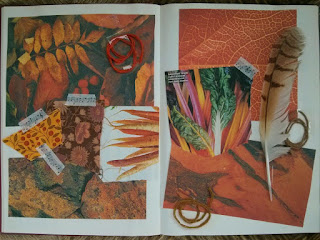To illustrate my blog post I'm going to use this crocheted hexagon blanket - it's also the source of inspiration for this topic so it seemed appropriate. The information I am sharing in this post is not just for crocheters - anyone who is seeking more advice on how to choose and combine colours should find it useful.
I've always enjoyed colour and combining colours together but it wasn't until my Portfolio Art Course at Angus College (now Dundee and Angus College) that I began to learn the science of colour theory. This new-to-me teaching and the further guidance and instruction I gained at art college (I studied at Duncan of Jordanstone College of Art and Design, Dundee) gave me the firm foundation that I now base almost all my colour choices on.
The colour wheel is the most common theory which I refer to when choosing colours. Nowadays I don't even think about it, it's like tying my shoelaces, but back then I learnt the principles and applied them every time. So, what is this colour wheel? I decided to have a play about with buttons to create one ...
The colour wheel is a diagram showing where all the colours are in relation to each other. There are 3 primary colours; RED, BLUE and YELLOW. These 3 colours are used in combination to form all the other colours. The secondary colours are ORANGE, GREEN and PURPLE - these are formed by mixing 2 primary colours together. For example, if you look at the colour wheel above, you can see that YELLOW and RED mixed together produces ORANGE. Now, half shut your eyes so that you are squinting at your screen - look at yellow then look at red and watch them blur into orange.
Complimentary colours (sometimes called contrasting colours) are the colours opposite each other on the colour wheel, ie. BLUE/ ORANGE, RED/ GREEN and YELLOW/ PURPLE. Note that each complimentary colour is made up of 1 primary colour and 1 secondary colour. When choosing colours, complimentary colours go well with each other, they compliment one and other and are usually a safe choice. The two complimentaries which I use over and over are BLUE/ ORANGE and PURPLE/ YELLOW. I tend to have "red and green should never be seen, except on the Christmas tree" in my head when I think of green and red together! However, they do often work; especially pale, lime green with a darker red.
In the image above you can see my clear use of yellow with purple (the most predominant colour combination in this blanket!) and in the centre pale green surrounded by darker reds.
The colours which are side by side on the colour wheel are analogous colours, ie. PURPLE/ BLUE, BLUE/ GREEN, GREEN/ YELLOW etc. If you are looking for a more subtle colour combination pick analogous colours (these are sometimes referred to as harmonious colours, you can see why!). If your colour scheme requires a trio of colours, choosing 1 primary colour with the 2 secondary colours either side is an excellent combination, ie GREEN/ BLUE/ PURPLE
White, black and grey are used to lighten or darken colours. There is a range called an achromatic scale which can be produced for each colour, starting with the pale, pastel shades through to the very dark, almost black shades. When choosing colours you may wish to stick with colours which are on a similar level of the chromatic scale (eg all pastels or all dark, moody colours) or you may wish to pick colours from different levels on the scale to create greater contrast in tone. I had fun with buttons again and created an achromatic scale for purple ...
So, that's all the basic colour theory that I wanted to share with you - if you're interested in finding out more there is a wealth of information to be found online or in your local library. In the second half of this blog post I want to pass on some practical tips on bringing the theory into your own colour choices.
One of my favourite ways of looking for new colour combinations is to play around with paint cards from the DIY store! Either keep them as they are (usually 3 to 5 colours in an achromatic colour scale) or cut the strips up to create isolated colour chips. Now try and form some colour trios, basing your 3 colours on the colour theory I have mentioned. There are infinite possibilities and there are no right or wrong answers, go on, explore! You may wish to start a notebook and glue your favourite combinations in it, ready to refer back to when you need inspiration.
Another technique is to create mood boards. Grab a pile of magazines (National Geographic magazines are my favourite for this and are usually fairly cheap in charity shops), some paint cards or fabric samples, scraps of wool, small items from a nature walk - whatever you have to hand - and get creative! If you don't feel like getting hands on, use Pinterest! You can search for millions of different images on Pinterest and if you don't feel like sharing your board with the rest of the world you can set it to "secret".
For colour inspiration the best piece of advice I could give you is to go out and explore! Take photos of colour combinations you find pleasing, draw or record in a notebook things you've seen, collect interesting colours (napkins, leaves, theatre tickets, flower petals, plastic washed up on the beach) - open your eyes, colour is just waiting to be found!
I hope you've found this blog post useful, let me know in the comments if you have! For more colour inspiration, follow me on Instagram.
Marta xx


















































